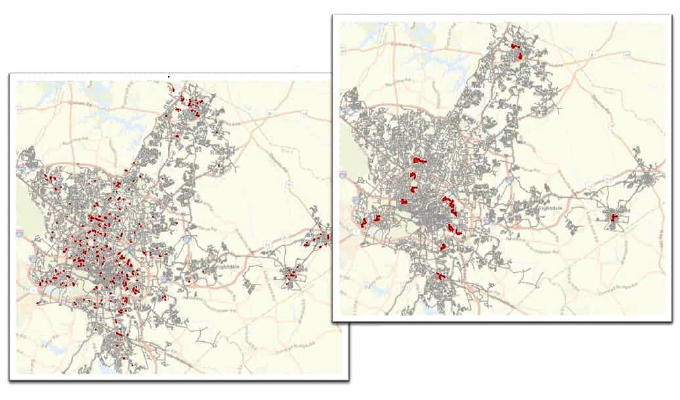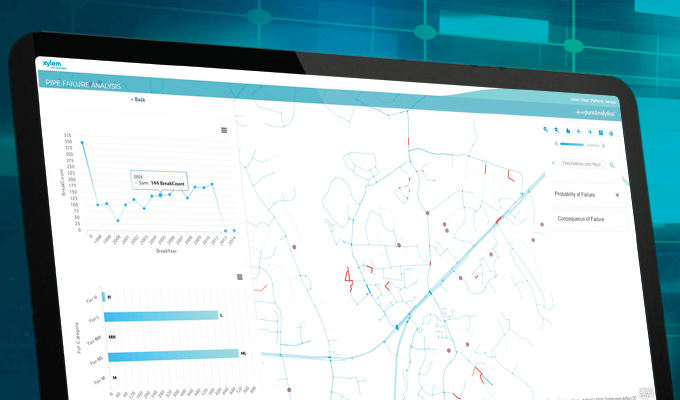By Rocio Echeverria, Xylem
PROJECT AT A GLANCE
| Client: | The City of Raleigh Public Utilities Department |
| Challenge: | Prioritize capital works using analysis to determine pipeline risk. |
| Partnership: | Xylem Inc. and Esri |
| Solution: | Raleigh Water partnered with Xylem to conduct a probability of failure analysis using historical data in their GIS and Xylem’s Asset Performance Optimization solution. |
| Results: | Reduced project planning time by 75 percent and developed a more efficient asset management program. |
Global water technology company Xylem has helped the City of Raleigh Public Utilities Department (Raleigh Water) get a clearer picture of its 2,340 miles of pipes, some of which are more than one hundred years old. Accurately predicting which parts of the pipe network might fail helps Raleigh Water pinpoint maintenance, avoid unnecessary digs, and reduce water main breaks.
Combining Xylem sensors and advanced risk analytics with Esri location intelligence software, Raleigh Water achieved a far more accurate, predictive, and targeted view of its potential trouble spots. Deciding which water mains to replace took 75 percent less time than in the past, while also reducing unnecessary capital costs and water loss from pipe failures.

RIGHT: Further analysis refined the probability of failure results, identifying clusters of similar high-risk pipe segments to help Raleigh Water build more efficient asset management plans now and in the future.
A HUGE CHALLENGE
“Based on what we’ve seen with Xylem’s predictive modeling services, we are confident that replacing these mains is the best bang for the buck,” says Adam Haggerty, asset manager for Raleigh Water. “This is a game changer for us, and it is something we will be able to use for a wide variety of applications.”
It’s a huge challenge to manage risk in a big pipe network. You have to predict failure in an asset you can’t see, knowing the pieces were built at different times in different ways. Get it wrong and you replace some pipes prematurely, while leaving higher-risk parts of the network in place. So, getting it right with advanced risk analytics gives the utility more confidence, saves the community money, and enables you to dig only when you have to.
“This is a great result for Raleigh Water, demonstrating the power in combining geographic information system data with insight into the water network, says Christa Campbell, director industry solutions: water, Esri. “We’re so pleased that, together, Esri and Xylem are bringing actionable new decision intelligence that delivers real savings by targeting work in the city where the need is greatest.”

USING HISTORICAL DATA FOR FUTURE SUCCESS
Xylem’s Asset Performance Optimization solution analyzed the utility’s entire network, combining historical pipeline break data with information from Raleigh Water using Esri ArcGIS Enterprise. The resulting assessment identified the top 1 percent of at-risk pipeline segments, scattered throughout the city, based on their probability of failure. The team then clustered groups of at-risk pipes to be prioritized for more targeted preventative maintenance.
The data-driven risk model also supports a city-wide initiative to increase racial equity by eliminating bias from selection of infrastructure projects. To date, Raleigh Water has planned six projects using the results of Xylem’s analyses. It estimates the work with Xylem has already saved the utility 75 percent of planning time while reducing risk to the network, decreasing response times, and lessening community impact of breaks that might occur.
FOR MORE INFORMATION
Rocio Echeverria is vice president and general manager at Xylem Vue—Xylem’s digital solutions platform that combines smart and connected technologies, intelligent systems and services, and over 100 years of problem-solving expertise. Xylem’s Asset Performance Optimization solution helps identify, prioritize, and quantify potential challenges in water pipeline networks before they negatively impact the community. Developed, supported and delivered by industry and technical experts, Asset Performance Optimization features in-depth pipe failure risk analytics and an Esri-based web application. For more information, visit www.xylem.com.
MODERN PUMPING TODAY, November 2021
Did you enjoy this article?
Subscribe to the FREE Digital Edition of Modern Pumping Today Magazine!



